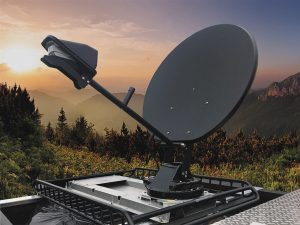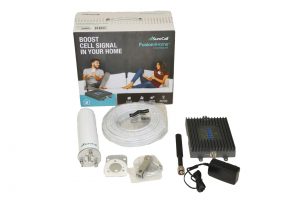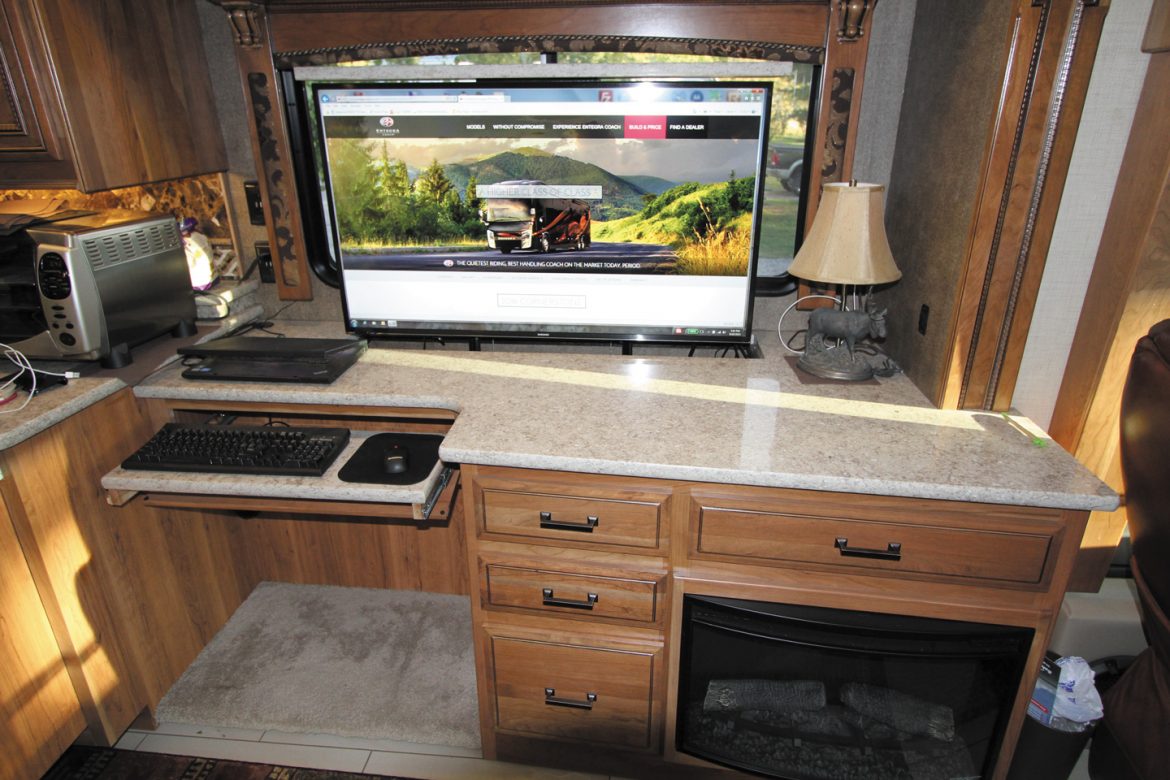By creating a work space and setting up the proper equipment, RVers can take their jobs wherever they roam.
By Mark Quasius, F333630
April 2021
Traveling in an RV doesn’t mean you have to disconnect from the world. In fact, a growing number of RV owners are using their vehicles to work remotely. The COVID-19 pandemic, which forced employees out of offices, schools, and other workplaces, created new opportunities for where and how the work gets done.

Many RV bunkhouse rooms provide study space.
While there are challenges to blending a work environment with one’s private life, more and more people are finding they like working remotely. Couple that with the huge shift in travel from cruise ships, airlines, and hotel stays to RVs, and the idea of a full-time work life on the open road in an RV is becoming increasingly appealing.
Requirements And Challenges
Not much difference exists between working remotely in a sticks-and-bricks residence or from an RV. All you truly need is a way to connect with others. Your physical location isn’t that important in this new virtual world, as long as you have the capability of communicating.
When working from home, you typically have access to some office space, even if it’s a spare bedroom that’s been converted to an office. But because an RV has limited space, some compromises must be made to prevent clashes between your work environment and your normal day-to-day living. If you only need to work on a part-time basis or to manage your investments, you may be able to set up your laptop on the dinette table between meals. If you need to spend a larger amount of time on the job, you’ll need a more convenient spot in which to work.
The need for separation between work and daily activities is an important factor in preventing friction within the family. If your job requires a bit of creativity, you don’t want to be in anyone’s way, and you need to find a cheerful environment where you can concentrate and let your creative juices flow. A dedicated work space is a big plus in achieving this. Depending on how large and how active your family is, you may be able to get by with a simple desk in your main living area. In fact, much of my writing and photography work is performed at a desk in our motorhome. My laptop sits on the desk, and a keyboard rests on a slide-out tray below it. When I’m not working, the laptop is moved and the desk becomes an entertainment center with a 50-inch TV on a power lift.

Toy-hauler garages, such as this KZ Venom area, provide plenty of office space, among other uses.
Dedicated spaces capable of being used as a home office also can be found in an increasing number of RVs. Some floor plans are tailored for larger families, with areas set aside for children. For example, fifth-wheels such as the Jayco Eagle have a game room in the middle of the RV that can be used for video game entertainment or as a study area — especially useful for families whose children are home schooled on the road. This area could be used as a home office as well.
Travel trailers with rear bunk rooms also provide plenty of space for an office; they include the Heartland North Trail and the Keystone Passport. Venture RV’s SportTrek Touring Edition has a floor plan with a rear multipurpose room. I also recall an Allegro Red Type A motorhome that featured a bunk-bed floor plan; the owner gutted the bunk beds and had the dealer convert that area to an office, complete with a multifunction printer, a desk, and plenty of electronics. Toy hauler garages also can work as a home office or home schooling study area. Many have the ability to let in a lot of natural light, creating a cheery environment. In some cases, the ramp can be lowered and the garage screened in to provide a closer link with the outdoors.
Connectivity

RF Mogul offers an automatic satellite dish designed for satellite internet access.
Of course, no work space would be complete unless you can connect with the outside world. Keeping in touch with websites, being able to send and receive email, and connecting to social media platforms are a must. There are various ways to access the internet. Campground Wi-Fi is the least expensive, assuming the campground in which you’re staying has free Wi-Fi available. But campground Wi-Fi has a reputation for being slow and spotty. Too many users with too many devices often task the system beyond its capabilities.
If you have a strong cellular signal, you can use an air card, a Jetpack, or a MiFi device that accepts a SIM card. This is the most popular method for RV owners who want to get online. These devices use the same cellular signal as your phone to access the internet, although they do require a separate account from a cellular provider.
Another option is to use your smartphone and set it up as a hot spot. This utilizes the phone’s cellular signal and converts it to a Wi-Fi signal that can be handed off to any Wi-Fi devices in your RV. The feasibility of this setup depends on your cell service provider’s plan. Some plans do not allow your phone to be used as a hot spot, and unless you have an unlimited bandwidth plan, you may run out of your monthly allocation of gigabytes and get cut off or throttled back to dial-up levels. Checking email and doing a bit of web browsing doesn’t require a ton of bandwidth. But if you stream movies, are an online gamer, or spend much of your life on YouTube, you can gobble up those gigabytes in a hurry.

The Winegard ConnecT 2.0 accepts both campground Wi-Fi and cell signals.
If you’re the type of RV owner who likes to truly get away from it all, you may find yourself in out-of-the-way places where a cell signal is weak or maybe nonexistent. In this case, satellite internet is your only option. An internet satellite dish isn’t the same as a satellite TV dish, so you’ll need to add a second dish to your RV. The dish can get expensive, and service provider packages are pricier than most cellular packages, though these packages have been coming down in cost over the years. There is also considerable latency — a delay in the signal — because it needs to bounce up several thousand miles to the satellite and back to Earth again. Latency isn’t a problem with normal web browsing and email, but it’s not suitable for interactive online gaming. Satellite dishes also don’t work well beneath heavy tree cover, because they need an open view of the southern sky. But if you are boondocking in the middle of nowhere, it’s your only option.
Regardless of which method you use to acquire your internet signal, you still need to deliver it to your various devices. For this, you’ll need a router. A router takes the incoming signal and creates a Wi-Fi hot spot that your computers, smart TVs, tablets, or any other Wi-Fi-enabled device can access. Most routers also have some sort of security protection so your signal stays private and others can’t steal your bandwidth or access your network. Some routers even have multiple input sources that can receive another Wi-Fi signal or cellular signal; this enables you to take advantage of any free campground Wi-Fi when available, saving your cellular bandwidth for another day. The Winegard ConnecT 2.0 is a device that mounts on the roof of your RV and allows you to easily switch between campground Wi-Fi and a cellular signal (via a SIM card) and then acts as a hot spot, rebroadcasting a secure Wi-Fi network within your RV.

The SureCall cell signal booster amplifies cellular signals inside an RV.
Sometimes, your cellular signal is present but is just too weak. In that case, you can improve your signal by adding a cellular booster. Cellular boosters require an external antenna that receives the signal, boosts it, and then relays it to a control module inside the RV, which then rebroadcasts that signal at a higher level than would otherwise be obtainable. I’ve added one of these to our motorhome, and it has made a huge difference. It provides a stronger signal to your air card or Jetpack, as well as to your cell phone.
The Great Adventure
Working from your RV can be a great adventure. If you have children and can home school them, you’ll expose them to so many things they never would experience by remaining home. If you have a job that allows you the flexibility to work from home, setting up that home office in an RV can make for a very enjoyable work environment.

